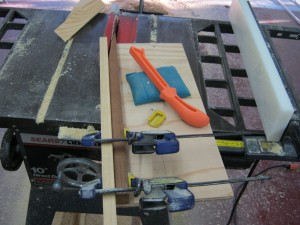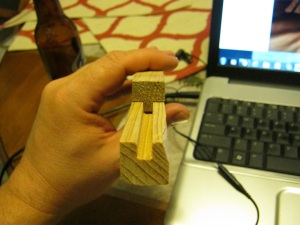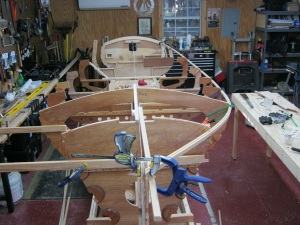As I sit here tonight I have four stringers cooking in the clamps for the second time. When last I reported in, I had laminated the upper stringers of Idle Hands. What I didn’t report is that was the last of the southern Bald Cypress that I had on hand.
My go to lumberyard for obscure stuff is Langs Building Supplies in Brunswick Georgia. So far it has been a constant source for all I need to build the boat. They have A/B marine fir and a selection of hard and soft woods in stock just waiting for a fool like me. It seems that Brunswick was, back in the day, quite the center for boat construction and the owners are trying to keep that alive in a small way. Unfortunately they are currently out of clear cypress and, to keep production up, that forced me to hit up the big box stores for a suitable substitute.
Through my wasted youth working construction I have found there is a lot of high end cabinetry in the Golden Isles area. Some of the best cabinet makers and high end carpenters make a living supplying the needs of St. Simons, Sea island, and Jekyll Island residents. I still haven’t figured out where they get there wood from. I spent the day before Thanksgiving with a list of suitable soft woods printed out and a long weekend to work on the boat.
Home Depot is known to have a better selection of fine woods in this area. I spent about an hour searching through the racks looking for something I could use. My first choice is Douglas Fir, mainly because you can use it for a substitute for aircraft spruce. No luck. Southern Yellow Pine or SYP is second on the list and there is plenty to be had. Unfortunately there are no pieces in the area that are free from major defects to make six stringers. In the end I settled for Radiata Pine. According to Google it has been used as a softwood in boat construction, its fairly rot resistant, and it glues well. I filled up my truck with enough to make six stringers and headed for the Idle Hands workshop where I scarfed and glued them into 20 foot lengths.
The day after Thanksgiving I set up my redneck steam box and placed the first two stringers in for an hour-long cook. While I was waiting, our good friends Mike and Gabby showed up on their motorcycle. They had been out riding and found their way over to our house. Being the good host I was I immediately put them to work.
Mike pulled the first stringer out from the steam box and Cheryl, Gabby, and I guided it to the frames of Idle Hands. With the clock ticking we bungeed the stringer in place from front to back. As we hit the hardest bend I heard Gabby say “Oh S&*^, I broke your boat!” Right in front of her the scarf joint let go. I looked at the break and it was if I had waxed the scarf joint before I glued it. It had failed with no damage to the wood at all. This was weird because the MAS epoxy had always penetrated whatever it was applied to. We regrouped and tried again with the same results. It broke right on the glue line again. Several cold beers eased my pain and allowed me to see what had gone wrong.
When I cut the scarfs in the pine it left almost a polished surface instead of the rough, open grain that I am used to with the cypress. It looks to me like the oils in the wood heated up and glazed over the joints which kept the glue from getting deep in the wood. I broke out the 60 grit and sanded a few offcuts to use as a test. This morning I went to the shop to test my samples to destruction. I am happy to say that opening up the grain with the sandpaper did the trick. My test samples did finally succumb to the will of my 48oz ball peen but they put up quite a fight. If the joints can handle the punishment I handed out today they will have no problem on the water.
By the time this is published I’ll be installing the stringers on Idle Hands. I hope there isn’t any more drama in store.


